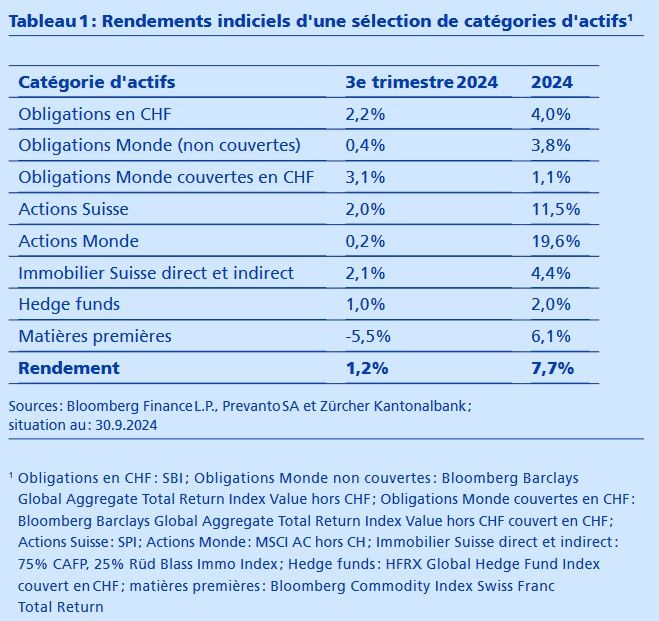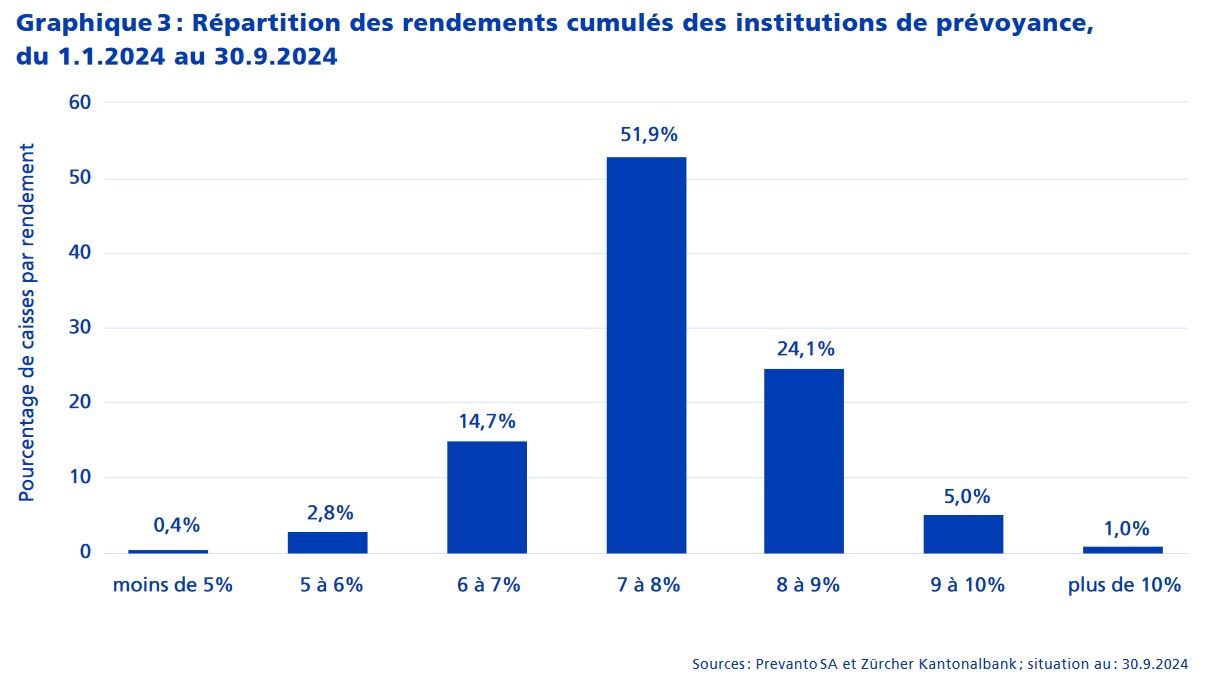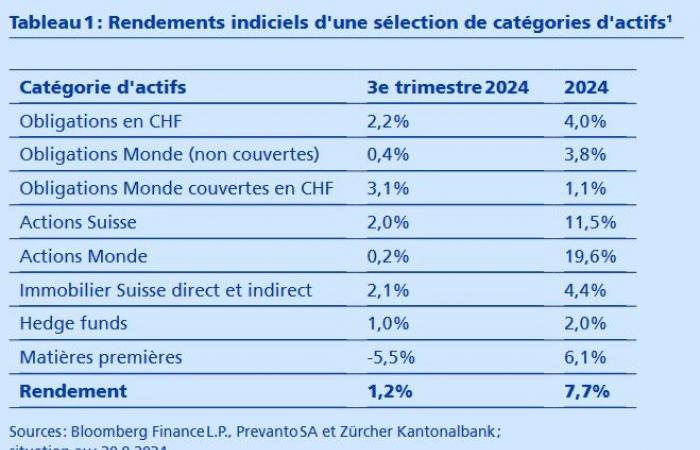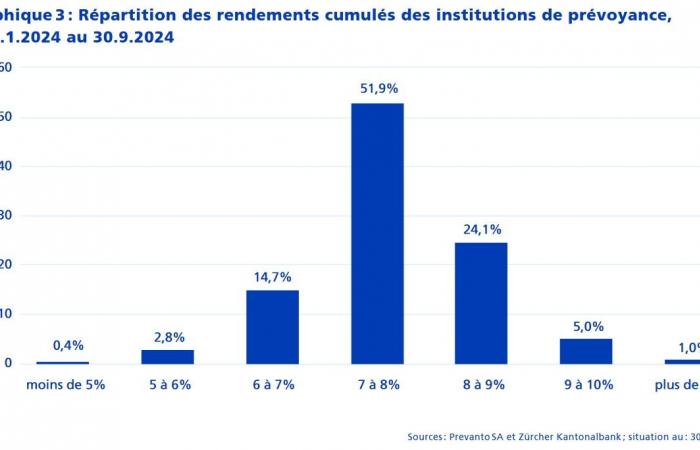Despite several phases of increased volatility in the third quarter of 2024, financial markets continued their slight upward trend during the period under review.
Thanks to the good performance of the majority of asset categories, an average pension fund achieved a performance of 1.2%, thus exceeding the return of the previous quarter. This encouraging trend is also reflected in the coverage levels of pension institutions: the average coverage level weighted according to the assets of a private law fund now stands at 120.7%.
Several global events led to increased volatility on financial markets in the third quarter of 2024: worsening geopolitical unrest, elections in France and Great Britain as well as the start of the US presidential elections caused unrest repeatedly. Monetary policy decisions by the US Federal Reserve (Fed) and the European Central Bank (ECB) have also raised investors’ pulses. The decided rate cuts, however, quickly calmed the situation. On the other hand, the disappointing quarterly figures of the large technology groups and the growing doubts about the possibilities of monetizing artificial intelligence have led to a real collapse of the corresponding values, also weighing on the overall market. Ultimately, however, equity markets proved resilient and benefited from the decline in inflation, as well as the prospect of a “soft landing” for the US economy following the significant rate cut. The Swiss stock market was also able to compensate for the temporary disturbances.
Bond markets, for their part, were hardly disrupted and maintained their progression, while government and corporate bonds posted solid returns. The rate cuts already made and the other expected measures integrated into the yield curves have produced the long-awaited normalization of these curves. For the first time in more than two years, the yield on two-year US Treasury bonds has fallen below that of ten-year US Treasury bonds. The real estate sector is the main winner from this drop in interest rates.
Thanks to the stable performance of the majority of asset categories, the coverage levels of private law pension funds once again recorded a modest increase, of 0.7 percentage points, to reach 120.7% in the third quarter 2024. The degrees of coverage weighted according to the assets of public law funds also show a slight continued increase: at the end of September 2024,
those with full capitalization now had a value of 113.0%, this figure being 90.1% for those with partial capitalization (graph 1).
Provident institutions by degree of coverage
In recent months, pension funds have been able to build up a significant financial reserve. 76.6% of private provident institutions already have coverage of 115% or more, compared to 74% in the previous quarter. In total, 93.3% of private law funds have coverage of more than 110%.
All fully capitalized public pension institutions now have an asset-weighted coverage level of at least 100%, with a value of 115% or more for 57.9% of them. On the other hand, the figures for partially funded public law pension funds have changed very little (graph 2).
Asset class returns in Q3 2024
The wealth-weighted return of the pension funds included in the survey is estimated to be 1.2% in the third quarter of 2024. The Swiss Franc Hedged Global Bonds asset class is the largest contributor to this return. , with 3.1%, while raw materials are clearly the laggards with a decline of 5.5%. However, over the whole of 2024, this asset category generated an increase of no less than 6.1%. Swiss stocks recorded a performance of 2.0%, bringing their return to 11.5% this year. Their return, however, remains significantly lower than that of global equities, at 19.6% over the period from the start of the year to the end of September 2024. The increase, however, is limited to only 0.2 percentage points (table 1).

Chart 3 shows the distribution of estimated cumulative returns, excluding fees, for the first nine months of 2024. The return weighted according to wealth for all funds amounts to 7.7% between the beginning of January and the end of September, and the unweighted return to 7.6%. The performance of each pension institution is updated based on index returns. These calculations are based on the asset allocation of the pension institutions as of December 31, 2023 and are based on the assumption that no major change has occurred in the allocation.

The Swisscanto Pension Fund Monitor is based on data from the Swisscanto “Swiss Pension Funds” survey managed by Zürcher Kantonalbank. The calculations are carried out by Prevanto SA. The estimates as of September 30, 2024 are based on the actual indications as of December 31, 2023 collected as part of the study on Swiss pension funds 2024. The estimates are established based on market developments and the allocation of assets declared at the end of 2023 by the respondents.
The performance of some illiquid asset classes, such as private equity, is approximated using index data published with a time lag. Therefore, until the latest figures are published, calculations of the performance of these asset classes are based on projections.
The performance of recent months may therefore change retroactively as new performance data is published. As the return on unlisted investments has recently been overestimated based on the approximation, the methodology of the pension fund monitor had to be slightly adapted.









